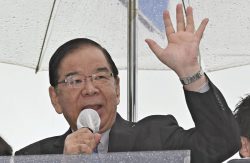14:30 JST, July 8, 2024
How will Tokyo Gov. Yuriko Koike approach the difficult task of dealing with the declining birth rate and aging population, and how will she build an easy-to-live-in, vibrant capital? It is a heavy responsibility to be entrusted to continue running the Tokyo metropolitan government.
Incumbent Koike won a third term in the Tokyo gubernatorial election. The main issue was the evaluation of Koike’s administration over the past eight years. The election indicated that the policies that she devised and put energy into, such as the monthly ¥5,000 subsidy program for children, have gained a certain amount of support.
There are many issues that Koike must tackle from now on. People from regional areas are flowing into Tokyo, raising the number of residents to 14 million, but at the same time the birth rate is declining and the population is graying. Tokyo’s population is expected to start declining in the not-too-distant future.
It is important to establish a support system so that people who wish to have children can give birth to them and raise them without anxiety. It is also essential to create employment and business opportunities.
In addition to strengthening medical and nursing care systems, there is also the urgent task of building up preparedness for disasters such as earthquakes that could occur directly under the Tokyo metropolitan area as well as torrential rain. Koike is urged to prioritize policies and steadily achieve results.
Koike has so far decided many important policies through discussions with a small group of senior officials in the metropolitan government. While this top-down approach has led to speedy management, it has also faced some opposition such as from Tokyo’s ward offices, which have been suddenly hit by financial burdens.
In her third term, there will be situations in which Koike’s ability to coordinate will be tested to ensure that she does not manage the metropolitan government in a heavy-handed manner.
The Liberal Democratic Party was unable to field its own candidate in the election. This is because the ruling party faced severe criticism as the hidden funds scandal involving its factions came to light, and the LDP ultimately turned to supporting Koike.
Koike adopted a strategy of keeping the support of political parties out of the foreground. The LDP had no choice but to refrain from any open activity, and the strategy ultimately worked.
Meanwhile, Shinji Ishimaru, a former mayor of Akitakata, Hiroshima Prefecture, who did not receive support from any political parties, actively used social media to expand his popularity especially among young people, thereby broadening his support from voters. Former House of Councillors member Renho, who received the full backing of the Constitutional Democratic Party of Japan and the Japanese Communist Party, failed to gain support.
The results show that voters are turning away from the established political parties, and this must not be taken lightly. The LDP, which is facing headwinds, and the CDPJ, which tried to find a way to make the most of its united front with the JCP, will likely be forced to rethink their strategies for future national elections.
In the gubernatorial election, which involved a record high of 56 candidates, many campaign posters unrelated to the candidates were put up on signboards, and there was also a string of undignified broadcasts of political views. How do we prevent such activities that mock voters? A serious issue of the deterioration of election was also brought to light.
(From The Yomiuri Shimbun, July 8, 2024)
"Editorial & Columns" POPULAR ARTICLE
-

Artificial Intelligence Expands Possibilities for Foreign Language Learners
-

Build Intellectual, Physical Strength, As Well As Communicative Power / Japan Should Move from Beneficiary to Shaper of World Order
-

Global Economy in Turmoil: Prevent Free Trade System from Going Adrift / Risks to Financial Markets Must Be Heeded
-

Japan-China Strain Set to Persist as Beijing Officials Self-Interestedly Bash Tokyo; Takaichi Unlikely to Back Down
-

Elderly People Living Alone: What Should be Done to Ensure Living with Peace of Mind until the End?
JN ACCESS RANKING
-

Japan Govt Adopts Measures to Curb Mega Solar Power Plant Projects Amid Environmental Concerns
-

Core Inflation in Tokyo Slows in December but Stays above BOJ Target
-

Major Japan Firms’ Average Winter Bonus Tops ¥1 Mil.
-

Bank of Japan Considered U.S. Tariffs, Coming Shunto Wage Hike Talks in Its Decision to Raise Interest Rates
-

Tokyo Zoo Wolf Believed to Have Used Vegetation Growing on Wall to Climb, Escape; Animal Living Happily after Recapture




























